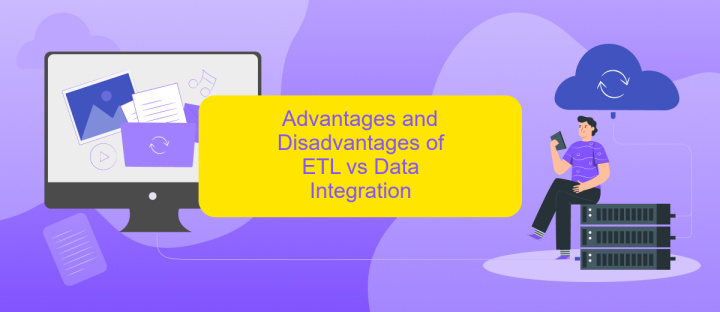ETL vs Data Integration
In the realm of data management, ETL (Extract, Transform, Load) and Data Integration are pivotal processes that ensure seamless data flow and usability across systems. While ETL focuses on extracting data from various sources, transforming it into a suitable format, and loading it into a target database, Data Integration encompasses a broader spectrum of techniques to unify disparate data sources. Understanding their differences is crucial for effective data strategy.
Introduction
In the rapidly evolving landscape of data management, understanding the differences between ETL (Extract, Transform, Load) and Data Integration is crucial for organizations aiming to leverage their data effectively. Both methods are essential for data processing, but they serve distinct purposes and offer unique benefits.
- ETL: Focuses on extracting data from various sources, transforming it into a suitable format, and loading it into a target system.
- Data Integration: Involves combining data from different sources to provide a unified view, often in real-time, without necessarily transforming the data.
Choosing the right approach depends on specific business needs, data complexity, and integration requirements. Tools like ApiX-Drive simplify the process of setting up integrations, enabling seamless data flow between various applications and systems. By understanding the distinctions and applications of ETL and Data Integration, businesses can make informed decisions to optimize their data strategies.
ETL vs Data Integration: Key Differences

ETL (Extract, Transform, Load) and Data Integration are both crucial processes in data management, but they serve different purposes. ETL focuses on extracting data from various sources, transforming it into a suitable format, and loading it into a target system, such as a data warehouse. This process is typically batch-oriented and is ideal for consolidating data from multiple sources to provide a unified view for analysis and reporting. ETL tools often come with robust transformation capabilities, making them suitable for complex data processing tasks.
On the other hand, Data Integration encompasses a broader range of activities, including real-time data synchronization, data migration, and data federation. It aims to create a seamless flow of data across various systems and applications, ensuring that information is consistent and accessible when needed. Services like ApiX-Drive facilitate data integration by providing pre-built connectors and automation features, enabling businesses to easily connect disparate systems without extensive coding. This makes Data Integration more adaptable to dynamic environments where data needs to be continuously updated and shared across multiple platforms.
Advantages and Disadvantages of ETL vs Data Integration

ETL (Extract, Transform, Load) and Data Integration are two fundamental approaches for managing and utilizing data within organizations. Each method comes with its own set of advantages and disadvantages.
- ETL allows for complex data transformations, ensuring that data is clean and structured before it reaches the target system. However, it can be resource-intensive and time-consuming to set up and maintain.
- Data Integration, on the other hand, provides real-time data synchronization across multiple systems, which is crucial for dynamic environments. The downside is that it may not handle complex transformations as efficiently as ETL.
- Using services like ApiX-Drive can simplify the integration process by offering pre-built connectors and automation, reducing the need for extensive coding. Nevertheless, relying on third-party services may introduce dependency risks and potential additional costs.
In summary, the choice between ETL and Data Integration depends on the specific needs and resources of an organization. While ETL excels in data preparation and transformation, Data Integration offers real-time connectivity and ease of use, especially when supported by tools like ApiX-Drive.
Choosing the Right Approach

When deciding between ETL (Extract, Transform, Load) and Data Integration for your data management needs, it's crucial to consider the specific requirements and goals of your organization. Both approaches offer unique advantages and can be more or less suitable depending on the context.
ETL is often the preferred choice for organizations that need to process large volumes of data from multiple sources and transform it into a structured format for analysis. It is particularly useful for building data warehouses and ensuring data consistency and quality.
- Data Complexity: ETL is ideal for complex data transformations.
- Real-Time Needs: Data Integration may be better for real-time data access.
- Scalability: Consider ETL for large-scale data processing.
- Ease of Use: Tools like ApiX-Drive simplify integration processes.
Ultimately, the right approach depends on your specific use case. For instance, if you need to integrate various applications and automate workflows without extensive coding, a service like ApiX-Drive can streamline the process, making Data Integration a more attractive option. Carefully evaluate your needs to choose the most effective strategy.


Conclusion
In conclusion, both ETL and Data Integration play crucial roles in managing and utilizing data effectively within organizations. ETL processes are essential for transforming and loading data from various sources into data warehouses, making it easier for businesses to analyze and derive insights. On the other hand, Data Integration focuses on combining data from different sources to provide a unified view, which is vital for real-time decision-making and operational efficiency.
Choosing between ETL and Data Integration depends on the specific needs and goals of an organization. For those seeking a streamlined and automated solution for integrating various applications and data sources, services like ApiX-Drive offer a robust platform. ApiX-Drive simplifies the integration process, allowing businesses to connect multiple systems effortlessly, ensuring data consistency and accessibility. Ultimately, the right approach will depend on the organization's data strategy, infrastructure, and long-term objectives.
FAQ
What is the difference between ETL and Data Integration?
When should I use ETL over other data integration methods?
Can ETL processes be automated?
What are the challenges of ETL and Data Integration?
How can I simplify the process of setting up data integrations?
Time is the most valuable resource in today's business realities. By eliminating the routine from work processes, you will get more opportunities to implement the most daring plans and ideas. Choose – you can continue to waste time, money and nerves on inefficient solutions, or you can use ApiX-Drive, automating work processes and achieving results with minimal investment of money, effort and human resources.

